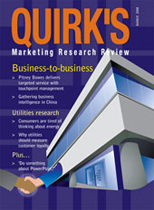Editor’s note: Charles H. Ptacek is president of Charles, Charles & Associates Inc., a Gold Canyon, Ariz., research firm.
Business-to-business (B2B) market research offers challenges not typically experienced with consumer research. It is frequently possible and often preferable to obtain market information through specifically focused exploratory research methods as opposed to the more costly and time-consuming survey methods that dominate marketing research practice. If one seeks to understand the dynamics of a B2B market, then a few carefully-selected, knowledgeable players (who are doing most of the business) may provide an accurate and representative platform to study because, in most B2B markets, high demand concentration spells a high degree of information concentration among a very limited number of sources. Among the most important differences between B2B and consumer goods and services markets are the following three factors:
1. Derived demand - The demand for B2B goods is ultimately dependent upon the demand for related consumer goods and is thus considered to be derived demand. It is therefore true that understanding the nature and scope of B2B markets requires understanding both the nature of demand facing the B2B customer and the customer’s customer throughout the marketing channel to measure actual consumer demand. The need to analyze market activity at all levels between the B2B customer and end users/consumers is the implication of derived demand in B2B markets.
2. Demand concentration - B2B markets are marked by three types of concentration and these three forms of concentration permit B2B marketing researchers to identify their markets more accurately than their consumer goods counterparts.
- A finite universe, which leads to a relatively limited customer base where the cost of sale can be high and opportunities for new sales are highly targeted.
- Purchasing concentration stemming from the structure of many B2B markets, whereby a few firms account for a high proportion of total market demand. This is the old 80-20 rule (20 percent of the companies account for 80 percent of the market demand), which is based on the Pareto principle: the principle of a vital few and a trivial many.
- Information concentration, where high demand concentration spells a high degree of information concentration among a very limited number of sources. This highly skewed distribution requires that careful attention be given to the selection of knowledgeable persons, using representative judgment samples rather than any random sampling method. The use of any random sampling techniques will produce its results from the least-meaningful population members.
3. Buying process complexity - The presence of multiple and varying buying influences associated with B2B purchase decisions is another important consideration for marketing research. More individuals are generally involved in B2B purchase decisions than in consumer purchasing decisions and, depending on the complexity of the purchase, the B2B process may span many weeks or months and involve the participation of several members of the organization, all of whom may bring different criteria to bear on the purchase decision. As a result, measurement of attitudes, motivations and relative influence on purchasing decisions is much more complex in B2B marketing research. Thus, the B2B market researcher must understand the process that an organization follows in purchasing a product and which organizational members have key roles in this process.
On the other hand, those involved in B2B purchasing decisions are far more knowledgeable about the purchase process and products and, consequently, can provide better information than the average consumer. In addition, trade relations between B2B producers and buyers tend to be closer, stronger and more continuous, often enhanced by the greater use of long-term purchase contracts. Hence, market research must be cognizant of the fact that buyer-seller interdependence is a salient dimension of B2B marketing.
Knowledgeable persons
One of the most important differences between B2B and consumer marketing research is found in the relative importance of surveys of knowledgeable persons. This method exploits the specialized knowledge and judgment of informed persons or experts to ascertain market intelligence that can be used by management to make better market-oriented decisions. B2B marketing researchers need to devote considerable time and effort to identify those very special persons who qualify as most knowledgeable about the products and markets of primary investigative interest.
The two keys to successfully performing a survey of knowledgeable persons are 1) identifying who to talk to and 2) achieving a convergence of informed opinion.
- Identifying experts: The selection of the panel of knowledgeable persons is critical to the success of the study. The key informant technique is used to identify knowledgeable persons and represents a form of networking persons in an industry, thereby identifying which persons are considered most knowledgeable; these are the persons who are recruited as experts. The pool of experts, or knowledgeable persons, is initially identified during the process of collecting relevant secondary information from trade publications and associations as well as industry source referrals.
- Consensus of opinion: With this approach, opinions of knowledgeable persons are converted into an informed consensus through a structured multi-step recruiting and polling process. In addition to the original in-depth interviews, recontact and supplemental interviews are usually performed. Recontact interviews are performed to achieve a convergence of opinion on critical issues or to obtain additional information. Supplemental interviews are often required when multiple sources exist and these particular experts are crucial to the convergence process.
Reliable, valid
Generally, a sample of less than 100 participants is often an acceptable number of knowledgeable persons to interview. This statistically indefensible sample may furnish far more reliable, valid and usable results than would a technically perfect sample of all the firms. It is, in fact, this situation that occurs for many business-to-business market research investigations.
